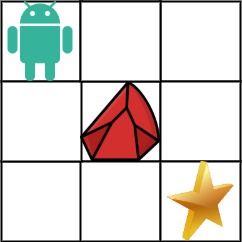Welcome to Subscribe On Youtube
63. Unique Paths II
Description
You are given an m x n integer array grid. There is a robot initially located at the top-left corner (i.e., grid[0][0]). The robot tries to move to the bottom-right corner (i.e., grid[m - 1][n - 1]). The robot can only move either down or right at any point in time.
An obstacle and space are marked as 1 or 0 respectively in grid. A path that the robot takes cannot include any square that is an obstacle.
Return the number of possible unique paths that the robot can take to reach the bottom-right corner.
The testcases are generated so that the answer will be less than or equal to 2 * 109.
Example 1:

Input: obstacleGrid = [[0,0,0],[0,1,0],[0,0,0]] Output: 2 Explanation: There is one obstacle in the middle of the 3x3 grid above. There are two ways to reach the bottom-right corner: 1. Right -> Right -> Down -> Down 2. Down -> Down -> Right -> Right
Example 2:

Input: obstacleGrid = [[0,1],[0,0]] Output: 1
Constraints:
m == obstacleGrid.lengthn == obstacleGrid[i].length1 <= m, n <= 100obstacleGrid[i][j]is0or1.
Solutions
Solution 1: Dynamic Programming
We define $dp[i][j]$ to represent the number of paths to reach the grid $(i,j)$.
First, initialize all values in the first column and first row of $dp$, then traverse other rows and columns, there are two cases:
- If $obstacleGrid[i][j] = 1$, it means the number of paths is $0$, so $dp[i][j] = 0$;
- If $obstacleGrid[i][j] = 0$, then $dp[i][j] = dp[i - 1][j] + dp[i][j - 1]$.
Finally, return $dp[m - 1][n - 1]$.
The time complexity is $O(m \times n)$, and the space complexity is $O(m \times n)$. Here, $m$ and $n$ are the number of rows and columns of the grid, respectively.
-
class Solution { public int uniquePathsWithObstacles(int[][] obstacleGrid) { int m = obstacleGrid.length, n = obstacleGrid[0].length; int[][] dp = new int[m][n]; for (int i = 0; i < m && obstacleGrid[i][0] == 0; ++i) { dp[i][0] = 1; } for (int j = 0; j < n && obstacleGrid[0][j] == 0; ++j) { dp[0][j] = 1; } for (int i = 1; i < m; ++i) { for (int j = 1; j < n; ++j) { if (obstacleGrid[i][j] == 0) { dp[i][j] = dp[i - 1][j] + dp[i][j - 1]; } } } return dp[m - 1][n - 1]; } } -
class Solution { public: int uniquePathsWithObstacles(vector<vector<int>>& obstacleGrid) { int m = obstacleGrid.size(), n = obstacleGrid[0].size(); vector<vector<int>> dp(m, vector<int>(n)); for (int i = 0; i < m && obstacleGrid[i][0] == 0; ++i) { dp[i][0] = 1; } for (int j = 0; j < n && obstacleGrid[0][j] == 0; ++j) { dp[0][j] = 1; } for (int i = 1; i < m; ++i) { for (int j = 1; j < n; ++j) { if (obstacleGrid[i][j] == 0) { dp[i][j] = dp[i - 1][j] + dp[i][j - 1]; } } } return dp[m - 1][n - 1]; } }; -
class Solution: def uniquePathsWithObstacles(self, obstacleGrid: List[List[int]]) -> int: if not obstacleGrid: return 0 m, n = len(obstacleGrid), len(obstacleGrid[0]) dp = [[0] * (n+1) for _ in range(m+1)] # dp[1][1] = dp[0][1] + dp[1][0] # so, set either dp[0][1]=1, or set dp[1][0]=1 dp[0][1] = 1 for i in range(1, m+1): for j in range(1, n+1): if obstacleGrid[i-1][j-1] == 0: dp[i][j] = dp[i-1][j] + dp[i][j-1] # else, ==1, obstacle, skip and leave as 0 return dp[m][n] ############ class Solution: def uniquePathsWithObstacles(self, obstacleGrid: List[List[int]]) -> int: m, n = len(obstacleGrid), len(obstacleGrid[0]) dp = [[0] * n for _ in range(m)] for i in range(m): if obstacleGrid[i][0] == 1: break dp[i][0] = 1 for j in range(n): if obstacleGrid[0][j] == 1: break dp[0][j] = 1 for i in range(1, m): for j in range(1, n): if obstacleGrid[i][j] == 0: dp[i][j] = dp[i - 1][j] + dp[i][j - 1] return dp[-1][-1] -
func uniquePathsWithObstacles(obstacleGrid [][]int) int { m, n := len(obstacleGrid), len(obstacleGrid[0]) dp := make([][]int, m) for i := 0; i < m; i++ { dp[i] = make([]int, n) } for i := 0; i < m && obstacleGrid[i][0] == 0; i++ { dp[i][0] = 1 } for j := 0; j < n && obstacleGrid[0][j] == 0; j++ { dp[0][j] = 1 } for i := 1; i < m; i++ { for j := 1; j < n; j++ { if obstacleGrid[i][j] == 0 { dp[i][j] = dp[i-1][j] + dp[i][j-1] } } } return dp[m-1][n-1] } -
function uniquePathsWithObstacles(obstacleGrid: number[][]): number { const m = obstacleGrid.length; const n = obstacleGrid[0].length; const dp = Array.from({ length: m }, () => new Array(n).fill(0)); for (let i = 0; i < m; i++) { if (obstacleGrid[i][0] === 1) { break; } dp[i][0] = 1; } for (let i = 0; i < n; i++) { if (obstacleGrid[0][i] === 1) { break; } dp[0][i] = 1; } for (let i = 1; i < m; i++) { for (let j = 1; j < n; j++) { if (obstacleGrid[i][j] === 1) { continue; } dp[i][j] = dp[i - 1][j] + dp[i][j - 1]; } } return dp[m - 1][n - 1]; } -
impl Solution { pub fn unique_paths_with_obstacles(obstacle_grid: Vec<Vec<i32>>) -> i32 { let m = obstacle_grid.len(); let n = obstacle_grid[0].len(); if obstacle_grid[0][0] == 1 || obstacle_grid[m - 1][n - 1] == 1 { return 0; } let mut dp = vec![vec![0; n]; m]; for i in 0..n { if obstacle_grid[0][i] == 1 { break; } dp[0][i] = 1; } for i in 0..m { if obstacle_grid[i][0] == 1 { break; } dp[i][0] = 1; } for i in 1..m { for j in 1..n { if obstacle_grid[i][j] == 1 { continue; } dp[i][j] = dp[i - 1][j] + dp[i][j - 1]; } } dp[m - 1][n - 1] } }